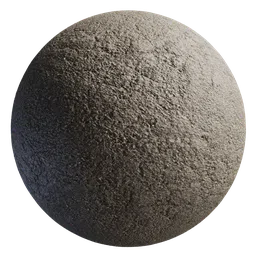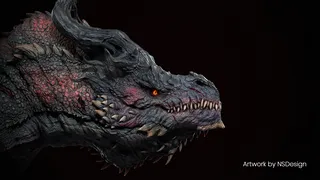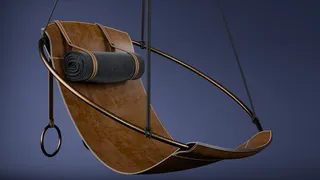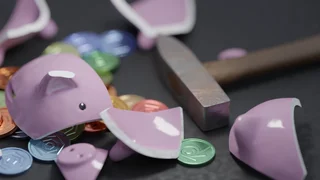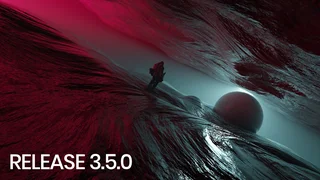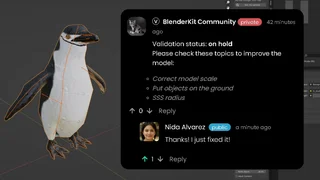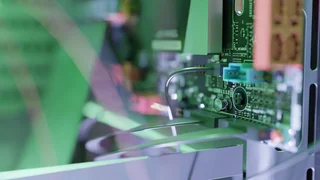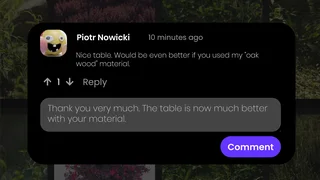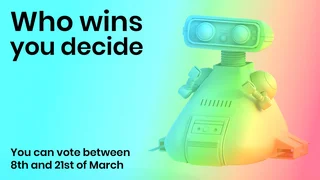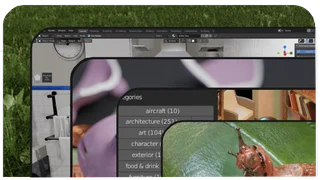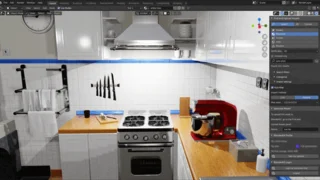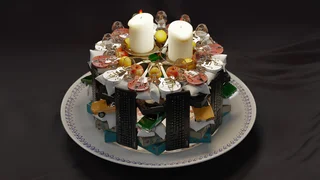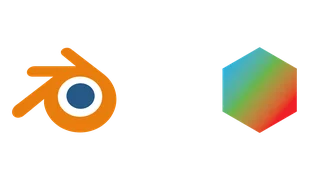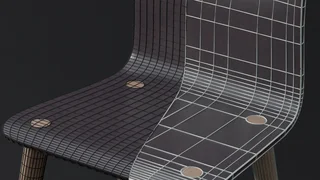There are many artists spending their precious time uploading their work to BlenderKit, often completely for free, and we want you to know who these are. That’s why with each asset, there is the author's personal statement and a link to the author’s website, no matter if it’s an individual or a company.
We created the first of the BlenderKit artists interviews with Julio Sillet, who has uploaded many great materials to our website. Check the great materials from Julio, and also his Youtube Channel.
“I always had a dream of creating a video game - it's my childhood dream.“
Read more about Julio Sillet’s path of becoming a 3d artist:
Vilem:
It's really nice to meet you, since I know about you only from your posts and uploads that I always open during validation.
Julio:
Yeah, it's great to meet you too.
Your platform really inspires me to finally take my textures study seriously.
Vilem:
Where are you from? What did/do you do, or do you study?
Julio Sillet:
The first question it's a little depressing. I'm from Venezuela, a country with a heavy conflictive situation. Right now I'm in Ecuador. I came 3 years ago trying to find a better future.
I'm technically an IT, I'm a superior technician in informatics. I graduated almost 9 years ago.
I have worked mostly on basements fixing computers for companies.
Vilem:
Thank you for your answers. I understand that having to move to a different country because of such reasons is a hard experience. How did you start with blender and creating materials for 3d artists?
Julio Sillet:
I always had a dream of creating a video game - it's my childhood dream. That is why I started with informatics. I wanted to learn to code because that was the first step to making games, and at the same time, I was investigating how to make 3d. I did not know anything about 3d so by searching on the internet I discovered 3dsmax XD. It was the most popular at the time, but I did not spend too much time with it. It was too expensive for a student like me.
I searched what were free alternatives. I found a tutorial from Andrew Price and discovered Blender. The famous donut tutorial. I believe it was 2.5 beta at the time. I was amazed with the sintel production. I still have the DVD back in my country.
Vilem:
Great. It's always surprising what impact BlenderGuru's tutorials had on the whole future of the CG industry. Open movies were definitely a brilliant move by Ton Roosendaal that showed people what Blender could do.
Julio Sillet:
Yeah. Making games it's still a dream of mine. Right now, I'm starting to focus on environment design. So what's better that start with PBR and textures to learn the basics. I wanted to master the fundamentals. How to make realism or at least archive pleasant materials visually.
For a while I was part of a Uplop studio, making shorts and movies with blender. In the studio we were together just like 2 years and even participated in the Suzanne Awards. In 2016, we did a mini-series for our government (I am not very proud of it). Tech, an educational series for children's. And a passion project called Hope - sadly that did not pass the teaser, but I am still very proud of it.
I learned a lot from that. Texturing, environment, lighting and postprocessing. It was a project that I made with my brother and a few friends. Sadly we split up as a team after that. We are each in a different country now. But I hope we can reunite and continue the short in the future.
Vilem:
I wish you that this happens in the future, the trailer looks really promising!
Julio Sillet:
Thanks, It was mostly a test to see if we were capable of achieving the quality we wanted. After that, I work as a freelancer making mostly architectural visualization jobs. But now I am trying to retake my passion and my dream of making a game. Obviously using blender as my main modeling tool. The 2.8x and eevee was a huge step to make the software more practical for game dev.
Vilem:
So If I understand it right, creating materials for you means studying a part of the skills you need to achieve your dream?
Julio Sillet:
Yeah, I'm trying to be a little systematic with my process. Once I feel more confident with the material creation and the PBR workflow, I'm going to start to make some simple real time environments in different engines. Including eevee, ue4 unity and godot. I want to experiment a lot.
Vilem:
Can you tell us about your daily routine? I can see you are doing a regular series of materials, by now most/all of them with Substance tools?
Julio Sillet:
Yes, of course. I don't really have a specific routine, but what I have is a weekly goal, at least 9 materials per week. Sometimes I can make it in a couple of days, and some time I spend days in 1 material. I am always trying to leave some time at night to play or see some Netflix, that helps me in my process too. Some of my materials are inspired by games or my favorite movies and series.
Vilem:
I’m happy to see how you switch between different groups of materials and to me it seems that you can make very diverse sets of materials. How do you pick what you create next?
Julio Sillet:
I have a list of themes that I brainstormed with the time. Usually, I watch some sci-fi movies, like Alien and think "whoa a sci-fi panels theme materials would look amazing" and add it to the list. But of course, I try to make something different each time, to complement my study.
Vilem:
I can see you dived into Substance Designer quite deeply, some of your materials are top-notch and they get tons of likes on social networks. How is it to be famous this way? I think your skills are now beyond what I'd expect from an indie game developer. Did you consider switching your career to texture/material artists at some studio?
Julio Sillet:
Yes, I use substance tools to make the materials. Textures are the first step of my study, and substance is the fastest way to make the textures available for everyone - in every CG package, people decide to use. But of course, I use Blender, to make the renders and always include a blend file with my materials, so it's easy to use and accessible.
Yes, I feel like I have progressed a lot in the last months. I'm very proud of it. But then, I see an artist like Joshua Lynch and Daniel Thiger and I see that I have a lot to learn yet.
Still, I'm very happy to see how much people like my materials. It really motivates me to keep working and studying.
Vilem:
I know you plan to start your own site with materials, can you tell us more about that?
Julio Sillet:
Yes, it is really not a big thing. I just want to make a place, so people can access my textures and resources more directly. I know that gumroad is not the best place to publish free resources. Some countries can’t even download from there, and if you are not a blender user, BlenderKit is not an option.
Vilem:
I definitely understand that, we focus on Blender now and put the possible reach to other applications quite low on our todo list (because there's still so much to improve inside Blender)
What do you think about the BlenderKit platform? What is your experience with it and what would you point out as what we should do next?
Julio Sillet:
One of the things that blender needs, and It is in development is the asset manager. A better way to organize all your assets, make libraries of materials, models. Maybe what Blenderkit needs it's an integration with the future asset manager.
Btw. I saw the updated addon for 2.82 and it's getting better each version.
Can I ask something? One of the blender 2.8 goals was an asset manager. I was really excited for that. Did you have something planned for that? like an integration?
Vilem:
Regarding the asset manager - we managed to have a small meeting at the conference since we would like to help with it. It's not in our capacity to develop it, since managing BlenderKit database by now takes most of the time we can give. We stay in touch with blender devs on the blender.chat and when the project starts moving, we'll help testing and it's definitely a plan to make BlenderKit as compatible as possible, probably converting it to an extension to the Asset manager.
It was a pleasure to hear from you and to meet you this way. I'm glad to know more about you and your life now.
Thank you for being part of BlenderKit, it makes my day to see people join in.
Julio Sillet:
You too, and thanks for making Blenderkit!






